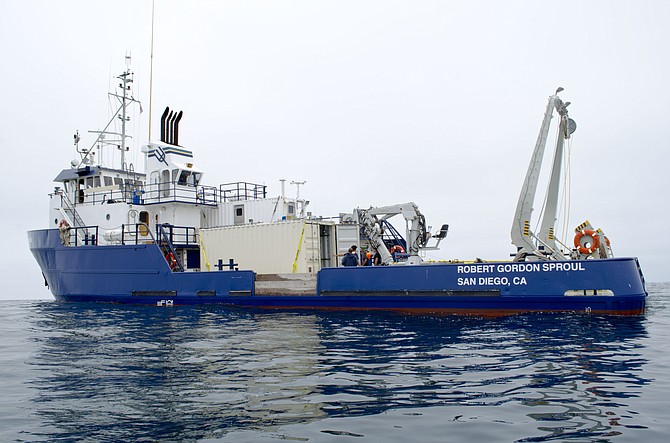 Facebook
Facebook
 X
X
 Instagram
Instagram
 TikTok
TikTok
 Youtube
Youtube

Commercial fishing boats near Scripps Pier must stay out of the adjoining areas, but La Jolla visitors might have noticed a ship recently prowling around the underwater reserve: the R/V Robert Gordon Sproul. During the week of September 11th, the Sproul, operated by Scripps Institution of Oceanography, came close to the pier and shore.
Students onboard were taking measurements inside Scripps Canyon, a narrow offshoot of the underwater La Jolla Canyon System that comes to within 500 meters of both Blacks Beach and the pier.
“It seemed like we were going to drive right up onto the beach sometimes, but then you’d look at the depth-sounder and see that the floor of the canyon was 100 meters below us,” said Madeleine Hamann, member of a group carrying out the La Jolla Internal Tide Experiment. The project studies how turbulence by internal waves moves nutrients up into the water column where they can be utilized by marine life in La Jolla Cove.
The team deployed one of only two shallow-water mapping systems in the world. The gear was towed behind the ship over six sections of the canyon, some for 25 hours each (two tidal cycles), picking up information on “temperature, salinity, water velocity, dissolved oxygen, turbidity (water clarity), chlorophyll fluorescence, and turbulence.” They attached moorings at three locations along the axis of the canyon system that will record long-term data.
Hamann and the team followed in the slipstream of Jacques Cousteau, who took his flying saucer into Scripps Canyon in the 1950s. It was too treacherous to go to the bottom. In the 1970s, a Scripps research crew put moorings in the canyon that were destroyed by strong currents within a week.
Hamann: “Today the Sproul successfully took measurements along the axis of the Scripps Canyon, and we lost nothing (aside from some fingernails, perhaps).”


Commercial fishing boats near Scripps Pier must stay out of the adjoining areas, but La Jolla visitors might have noticed a ship recently prowling around the underwater reserve: the R/V Robert Gordon Sproul. During the week of September 11th, the Sproul, operated by Scripps Institution of Oceanography, came close to the pier and shore.
Students onboard were taking measurements inside Scripps Canyon, a narrow offshoot of the underwater La Jolla Canyon System that comes to within 500 meters of both Blacks Beach and the pier.
“It seemed like we were going to drive right up onto the beach sometimes, but then you’d look at the depth-sounder and see that the floor of the canyon was 100 meters below us,” said Madeleine Hamann, member of a group carrying out the La Jolla Internal Tide Experiment. The project studies how turbulence by internal waves moves nutrients up into the water column where they can be utilized by marine life in La Jolla Cove.
The team deployed one of only two shallow-water mapping systems in the world. The gear was towed behind the ship over six sections of the canyon, some for 25 hours each (two tidal cycles), picking up information on “temperature, salinity, water velocity, dissolved oxygen, turbidity (water clarity), chlorophyll fluorescence, and turbulence.” They attached moorings at three locations along the axis of the canyon system that will record long-term data.
Hamann and the team followed in the slipstream of Jacques Cousteau, who took his flying saucer into Scripps Canyon in the 1950s. It was too treacherous to go to the bottom. In the 1970s, a Scripps research crew put moorings in the canyon that were destroyed by strong currents within a week.
Hamann: “Today the Sproul successfully took measurements along the axis of the Scripps Canyon, and we lost nothing (aside from some fingernails, perhaps).”
Comments